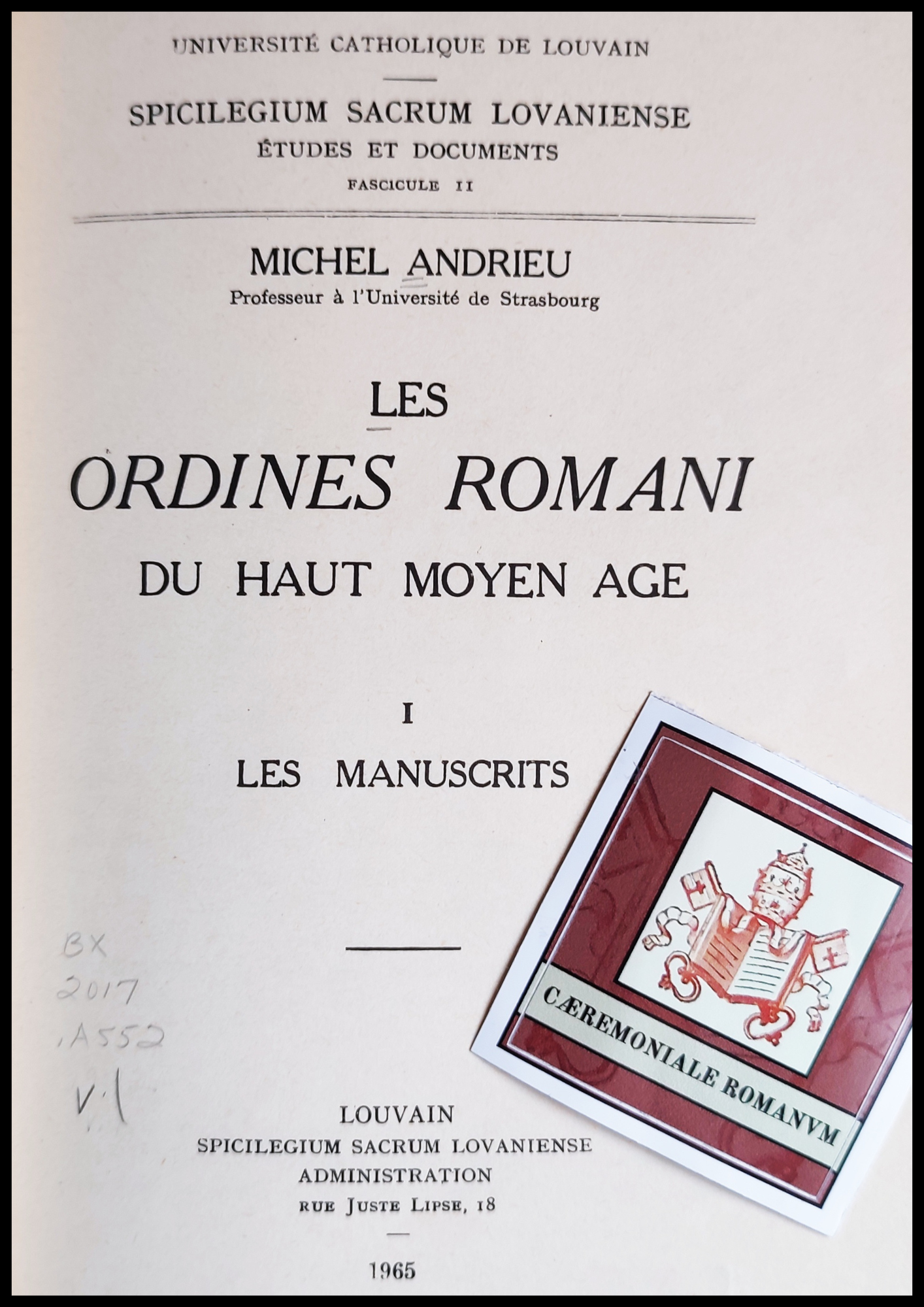
The Roman Orders (Ordines Romani) are, as the name suggests, liturgical ordering (ordo) documents that have their source in the Roman (papal) liturgy. They describe the course of various liturgical rites (Holy Mass, administration of the Sacraments, coronations) – primarily in ceremonial terms. They functioned as a supplement to books containing liturgical prayers (mainly ancient Sacramentaries).
It is commonly assumed that the oldest Roman Orders were created at the turn of the 7th and 8th centuries. They were created and written down primarily in Italy and Franconia until the 10th century. They disappeared with the creation of the Pontificale Romano-Germanicum, although they were still in use for some time. We can say that they were „absorbed” and „assimilated” by the Roman prototypes of post-Tridentine liturgical books (Pontificale Romanum, Rituale Romanum, Missale Romanum, Caeremoniale Episcoporum), and at the same time they were replaced by increasingly detailed books and collections of texts.
The Ordines Romani are monuments of the medieval Roman liturgy. They are an invaluable source of knowledge for liturgists, historians, and theologians alike, as evidenced by ongoing research and published studies (for example, scholars continue to thoroughly discuss the manuscripts and the impact on the development of the Roman rite of the Ordo Romanus Primus describing the ceremonies of the solemn papal Mass).
The texts of the Roman Orders were first published by Melchior Hittorp (1525-1584) under the name Ordo romanus vulgatus in his work De Divinis Catholicae Ecclesiae Officiis ac Ministeriis, Varii Vetustorum Aliquot Ecclesiae Patrum ac Scriptorum Libri (Cologne 1568). The Benedictine monks Jean Mabillon (1632-1707) and Michel Germain compiled the Ordines Romani systematically for the first time, publishing fifteen of them in the second volume of the famous Museum Italicum (Paris 1678-1689): Musei Italici Tomus II complectens Antiquos Libros Rituales Sanctae Romanae Ecclesiae Cum Commentario Praevio in Ordinem Romanum (their numbering of Ordines was used in later liturgical literature). The next author who drew attention to them was Edmond Martène (1654-1739), known for his study De Antiquis Ecclesiae Ritibus (Rouen 1700-1702).
However, it was the Oratorian Michel Andrieu (1886-1956), inspired by Father Louis Duchesne (1843-1922), who made a critical study of as many as fifty Roman Orders, to which he devoted several decades of his professorial work (the last volume was published after his death). This work still stands today as one of the twentieth-century opus magnum of the history of the Roman liturgy, and is still un ouvrage de référence for scholars around the world.

—
In the spirit of open science, we are making available the complete five volumes of Professor Michel Andrieu’s Les Ordines Romani du haut moyen âge. We hope that it will help not only professional scholars, but also amateurs and liturgy enthusiasts study and love the public worship performed by and in the Church. Bonum est diffusivum sui esse! Ut in omnibus Deus glorificetur!

Michel Andrieu, Les Ordines Romani du haut moyen âge, vol. I: Les manuscrits, Spicilegium Sacrum Lovaniense 11, Louvain 1931, 631 p.

Michel Andrieu, Les Ordines Romani du haut moyen âge, vol. II: Les textes (Ordines I-XIII), Spicilegium Sacrum Lovaniense 23, Louvain 1948 (1960), 536 p.

Michel Andrieu, Les Ordines Romani du haut moyen âge, vol. III: Les textes (suite) (Ordines XIV-XXXIV), Spicilegium Sacrum Lovaniense 24, Louvain 1951 (1961), 633 p.

Michel Andrieu, Les Ordines Romani du haut moyen âge, vol. IV: Les textes (suite) (Ordines XXXV-XLIX), Spicilegium Sacrum Lovaniense 28, Louvain 1956, 543 p.

Michel Andrieu, Les Ordines Romani du haut moyen âge, vol. V: Les textes (suite) (Ordo L), Spicilegium Sacrum Lovaniense 29, Louvain 1961, 418 p.
—

To facilitate navigation and work, we have prepared a simplified table with a list of all the Ordines Romani according to Michel Andrieu’s numbering, indicated dates and places of their origin (most often approximate), and the rites they describe or indications they contain1.
| No. | Content | Date | Place of origin |
| I | Solemn Papal Mass | 690-700 | Rome |
| II | Appendix to I | 690-700 | Rome |
| III | Appendix to I | 690-700/750 | Rome / Franconia |
| IV | Review of I | 790-800 | Franconia |
| V | Review of I | 850-900 | Rhineland |
| VI | Review of I | 850-900 | Metz (?) |
| VII | Canon Missae | IXth c. | Franconia |
| VIII | Pontifical Vestments | 850-900 | Franconia |
| IX | Bishop’s Mass | 880-900 | Franconia |
| X | Bishop’s Mass | 900-950 | Mainz (?) |
| XI | Baptism | VIIth c. (550-600+) | Rome |
| XII | Officium (Ordo) | 700-750 | Rome |
| XIII | Ordo of the Readings of the Office | VII-XIth c. | Franconian countries |
| XIV | Ordo of Readings in St. Peter’s Basilica | 650-700 | Rome |
| XV | Capitulare Ecclesiastici Ordinis | 775-800 | Franconian countries |
| XVI | Instructio Ecclesiastici Ordinis | 775-780 | Franconian countries |
| XVII | Breviarium Ecclesiastici Ordinis | 780-800 | Franconian countries |
| XVIII | Monastic Breviary | 775-780 | Franconian countries |
| XIX | Ordo of the Monastic Meal | 775-780 | Franconian countries |
| XX | Ordo of the Feast of the Purification | VIIIth c. | Franconian countries |
| XXI | Litaniae Maiores | VIIIth c. | Franconian countries |
| XXII | Ordo of Lent | 780-800 | Franconian countries |
| XXIII | Holy Thursday and Holy Saturday | 700-750 | Rome |
| XXIV | Office of Holy Week (Wed.-Sat.) | 750-800 | Franconian countries |
| XXV | Blessing of the Paschal Candle | 800-850 | Franconian countries |
| XXVI | Night Office of the Triduum Sacrum | 750-775 | Rome |
| XXVII | Appendix to XXVI | 700-750 (?) | Franconian countries |
| XXVIII | Sunday in the Octave of Easter / Easter Vigil | 800 / VI-VIIth c.. | Franconian countries / Rome |
| XXIX | Monastic Ordo of Holy Week (from Thu.) | 870-890 | Franconian countries |
| XXX | Holy Week Ordo (Thu.-Sat.) | 750-800 | Franconian countries |
| XXXI | Ordo of the Office of Sunday in the Octave of Easter | 850-900 | Franconian countries |
| XXXII | Triduum Sacrum (Ordo) | 880-900 | Franconian countries |
| XXXIII | Triduum Sacrum (Ordo) | Xth c. | Franconian countries |
| XXXIV | Priestly Ordination | 750 | Rome |
| XXXV | Priestly and Episcopal Ordinations | 900-1000 | Franconian countries / Rome |
| XXXVI | Degrees of the Roman Hierarchy | 880-900 | Rome |
| XXXVII | Priestly Ordination (Ember Days) | 800-900 / 825 | Franconian countries / Rhineland |
| XXXVIII | Priestly Ordination (Ember Days) | 940 | Rhineland |
| XXXIX | Ordination in the Roman Church | 790-800 | Rome |
| XL | Episcopal Ordination | VIth c. | Rome |
| XLI | Gallican Ordo of Church Dedication | 750-775 | Franconian countries |
| XLII | Roman Ordo of the Dedication of the Church and the Deposition of Relics | 700-750 | Rome |
| XLIII | Order of Transferring Relics | 790-800 | Franconian countries |
| XLIV | Ordo de Diligentia to St. Peter | 790 | Rome |
| XLV | Coronation of the Emperor | 900 | Franconian countries / Rome |
| XLVI | Coronation of the Emperor | 1050 | Franconian countries |
| XLVII | Coronation of the Emperor | 1050 | Franconian countries |
| XLVIII | Emperor’s Coronation Mass | 1050 | Franconian countries |
| XLIX | Funeral | VIIth c. | Rome |
| L | Order of the Liturgical Year | 950 | Germania |
- Also based on: Bogusław Nadolski, Wprowadzenie do liturgii, Kraków 2004, p. 335-337. ↩︎
—

RECOMMENDED READINGS
- Łukasz Żak, Ordo Romanus I – polskie tłumaczenie, „Roczniki Teologiczne Warszawsko-Praskie” 18(2023), p. 137-189.
- Arthur Robert Westwell, The Dissemination and Reception of the Ordines Romani in the Carolingian Church, c.750-900, doctoral dissertation, University of Cambridge, 2018.
- Eric Palazzo, Histoire des livres liturgiques, vol. 1. Le Moyen Âge : des origines au XIIIe siècle, Paris 1993 / History of Liturgical Books from the Beginning to the Thirteenth Century, Collegeville 1998.
- Cyrille Vogel, Introduction aux sources de l’histoire du culte chrétien au Moyen Âge, Spoleto 1975 / Medieval Liturgy. An Introduction to the Sources, Washington 1986.
- Cyrille Vogel, L’œuvre liturgique de Mgr M. Andrieu. Un bilan provisoire, „Revue des sciences religieuses” 31(1957), p. 7-19.
- Cyrille Lambot, Les «Ordines Romani» du haut moyen age édités par Mgr Michel Andrieu, „Revue Bénédictine” 62(1952), p. 302-306.

